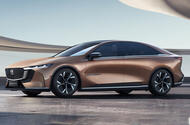EZ-6 is Mazda’s second electric car, after the MX-30 crossover
Striking Tesla Model 3 rival will be exported to Europe from China, and a UK launch is on the cards
Mazda will bring a striking new electric saloon to Europe as a rival to the BMW i4 and Tesla Model 3.
The EZ-6 was revealed at the Beijing motor show earlier this year as an electric successor to the mid-sized Mazda 6, produced by the Japanese firm’s joint venture partner Changan Mazda in China.
The Japanese company had previously given no indication of plans to sell the car outside of that market, but it has now signed an “agreement on electric vehicle export cooperation” with Changan Mazda, which will become “its exclusive Chinese new energy R&D and production base facing the global market”.
The announcement means that “the Mazda EZ-6 will be Mazda’s first global new energy vehicle”, the company said, adding that it will launch in the Chinese and European markets from autumn this year.
Autocar understands a UK launch is possible as part of this global push, but a decision has yet to be made.
Mazda currently sells just one electric vehicle in Europe, the MX-30 compact SUV, and in the first half of this year achieved just a 5% electric vehicle sales mix in the UK – around half that of Toyota and a quarter of Lexus.
The EZ-6, theoretically, could significantly alter that balance, given that its size and shape – it measures 4921mm long and has a 2900mm wheelbase – line it up neatly as a direct rival to the likes of the Tesla Model 3, Polestar 2 and BMW i4 – some of the most popular EVs on the market.
There has been no word on pricing yet, but Chinese-built electric cars are now subject to significant import tariffs in the EU. Cars built by Changan, specifically, will incur duties of 20.8%, meaning the EZ-6 is unlikely to be priced as a value alternative to the mainstream contenders.
The EZ-6 is technically unrelated to any Mazda model currently on sale, being based on a modular platform supplied by Changan, dubbed ‘EPA’.
Already used in China for the similarly sized Deepal SL03 saloon, this platform can accommodate pure-electric and range-extender (REx) drivetrains, as well as as Qualcomm-powered Level 4 self-driving functionality – though the EZ-6 will initially be limited to level 2.5, which still requires constant human supervision.
The EZ-6 will be offered as either a pure-EV with a 218bhp rear motor and an estimated range of 373 miles, or as a REx – an increasingly popular option in China – with a claimed total range of around 745 miles.
It is unclear whether the global export plans apply to both powertrain formats, but the Mazda MX-30, notably, is uniquely available as a pure-EV and a range-extender in the UK.
Mazda emphasises that although the EZ-6 is electric, it has “leveraged its extensive expertise in dynamic performance tuning from the gasoline vehicle era to elevate driving pleasure”, with engineers from the company’s European R&D centre travelling to China to contribute to the car’s development programme.
It will, the company suggests, embody the same ‘Jinba-Ittai’ – meaning “car and driver as one” – ethos as the petrol-powered 6, with a 50:50 weight distribution, multi-link rear suspension and an electric rear spoiler that aids high-speed stability.
The interior, like many Chinese-market EVs, is a minimalist but luxurious affair that majors on touch and voice control functionality, dominated by a 14.6in infotainment screen and with physical controls limited to haptic switches on the steering wheel.
Alongside the EZ-6 at the Beijing motor show in April, Mazda and Changan revealed the Arata concept as a vision of an SUV model which is set to enter production next year atop the same architecture. They have not yet confirmed plans to sell it outside China.







